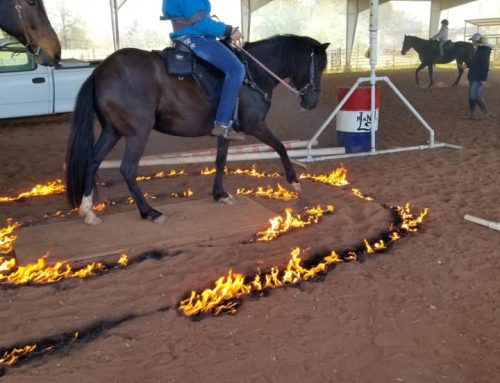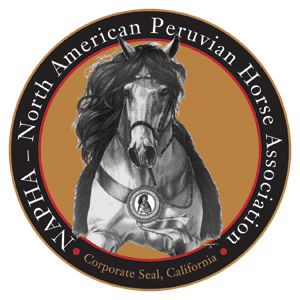If you have ever been to a Peruvian Horse Show or attended a parade or event where there are Peruvian Paso horses, you have probably wondered “what is all that ‘stuff’ the horses are wearing?”
Well, it’s a time-honored tradition. At one time there was a use for the various pieces of the tack. Today it is used mostly to carry on the tradition, not necessarily function, of the Peruvian horse. Below is a horse dressed in the traditional tack with explanations of the pieces.
- Finely plaited, hand-made goat rawhide bridle (Cabezada) and reins (Riendas) with silver or nickel decorations.
- Tapa Ojos or eye covers consisting of two diamond-shaped leather patches worn on the forehead. They can be lowered easily and are used to teach a horse to stand in one place indefinitely. They came in handy to immobilize a horse in Peru’s treeless desert where places to tie a horse are virtually non-existent.
- Hand-made halter (Jaquima) to match the bridle and reins, with a long shank used to longe the horse before the rider mounts.
- Lightweight sturdy saddle (Montura) with a comfortable seat built to suit the gait of the Peruvian Paso. It is similar to the saddles ridden by the knights around 1450 to 1500 and to the Estradiota saddle used in the first half of the 1600’s. The Peruvian saddle is made to hold the rider in the horse’s center and comfortably “boxed” in.
- Crupper (Batacola) which encircles the tail and buckles to the back of the saddle to hold it securely in position, keeping it from sliding forward when riding over rough terrain.
- Tail cover (Tapacola or Floron) and trimmings (Retrancas). Leather straps (retrancas) are connected to either side of the saddle and behind where it connects to the tapacola. The tapacola widens to a decorative piece that covers the baticola as well as the dock and upper art of the tail. The retrancas were originally designed to help keep the horse’s hind legs tucked under him. It keeps young horses from breaking the paso gait when touched by anything strange. Named los retrancos, it has kept horses from lashing out at anything that comes in contact with the legs. In the distant past it was common to see horses’ rumps decorated in this fashion with the tapacola being very decorative. The Royal Horse and Rider: Paintings, Sculpture and Horsemanship, 1500 to 1800 by Walter Liedtke, has many pictures of riders, riding in box saddles adorned with decorative tail pieces. In addition, the custom is preserved from the Spanish, who hung tapestries and other decorations over the rear quarters of their horses.
- Corona. A leather pad that goes between the saddle blanket and the saddle. It is two pieces of leather sewn together, slightly larger than the saddle. It is decorated with the same motifs as the saddle. Besides enhancing the appearance of the saddle, it protects the back of the horse from the weight of the rider. Beneath the corona is a saddle blanket to absorb sweat and protect the horse’s back. The traditional blanket is slightly smaller than the corona and is made of woven wool.
- Cincha (cinch) – The cincha is responsible for the safety of the rider. It gives stability and secures the saddle to the back of the horse.
- Estribos (stirrups) – The stirrups are wooden pyramids with a toe hole carved in one side. They could be plain or carved in a fancy manner. In the early days they were made of gold and silver, then changed to wood. They were sometimes adorned with semiprecious stones and were the most costly part of the attire, weighing up to 40 pounds. In the past, they served many purposes. Buried in the sand with only the top of the stirrup leather exposed, they were a desert hitching post. If detached from the saddle, they could be a formidable weapon. If they held a candle instead of a boot, they became a lantern, and they could be used as cups for thirsty riders. Traditionally for the show ring, they are made of mahogany and silver or nickel. Working stirrups are made of metal and leather-hooded.
Other items of traditional Peruvian gear:
Pellon. This can be added as a kind of tapestry and comfort over saddles with skirts. It is made of thousands of hand tied spit braids made from black dyed wool and inserted into a rug type backing. The underside is lined with fine kid leather and usually contains pockets. The pockets were used to keep valuable belongings when horses were the principal method of transportation. It takes about three months of intense labor to make and will weigh about 35 pounds when finished. The pellon could be used as bedding when long journeys required the rider to dismount and rest. It compliments Peruvian show tack,and is a sign of wealth and good taste.
The rider’s apparel:
A Poncho is a rectangular garment with a slit in the middle for the head. The ones worn in the sierra are normally made of sheep or alpaca wool. The poncho worn on the coast is normally woven of cotton, or linen, and is usually white, with narrow striping on all sides. The poncho is intended to serve a purpose. In the sierra, the rider wears it as protection against the cold, while on the coast it serves to keep off the dust.
A neckerchief (panuelo) is a square piece of fabric usually made of raw silk or some similarly fine material. It is fastened around the rider’s neck to further cover the poncho’s slit and prevent dust from entering. It may be tied into a knot or run through a band which often bears the rider’s initials.
The hat or sombrero is made of the finest weave made. It is woven of fine straw; Palma (palm) straw which originated from the areas of Puerto de Eten and Monsefu, in the coastal northern state of Lambayeque; and the Jipijapa straw, produced almost exclusively in the Piura area, in the town of Catacaos in far northern Peru. The Lima hat traditionally has a smaller brim, whereas the northern one is considerably larger. In the south, in areas subject to frequent rains, the hat is often made of felt. Therefore, climatic conditions often dictate the type of hat to be worn.
The show ring apparel tradition:
When South American ranchers go calling on each other, they wear white, and ponchos are worn to protect the rider from the dust of the trail and the sweat of the horse. So, in the show ring, the tradition is to wear white trousers and shirt over which a poncho is worn, a colored scarf, sombrero and white gloves, although it is rare to see white gloves in the show ring.
*For further in-depth, and technical explanation of Peruvian Tack, the following four-part series of articles has been scanned from issues of the Peruvian Horse Review. These articles were written by Carlos Luna de la Fuente in April 1966; Lima, Peru.
Winter 1980-81 – Saddle and Tack in the Peruvian Custom – Prologue – Part I
Spring 1981 – Saddle and Tack in the Peruvian Custom – Part II – Garnicion
Summer 1981 – Saddle and Tack in the Peruvian Custom – Part III – The Pellon
Winter 1982 – Saddle and Tack in the Peruvian Custom – Part IV – The Rider’s Apparel
Click on this link to read these informative articles: Four-part series Saddle and Tack in the Peruvian Custom .docx
References:
- The Peruvian saddle; Perol Chico Equestrian; www.Perolchico.com/post/the-peruvian-saddle
- Aldrich, Cheryl (1992); repinted (January 3, 2016), The Peruvian Saddle: A time-honored tradition; Rain Tree Peruvian Horse & Tack
- The Peruvian Paso in the United States; (November 19, 1966); Official Program of the National Peruvian Horse Show
- Oneal, Tunis (May 1966); Paso Finos in Arizona; Western Horseman
- Albright, Verne (February 1972); The Peruvian Paso Horse; American Horseman
- Engemann, Barbara & Zumach, Ed; (August-September 1971); The Peruvian Pasos of Cave Creek; Arizona Horseman
- Albright, Verne; The Traditional Peruvian Gear; reprinted from Cypress Ridge Ranch brochure





